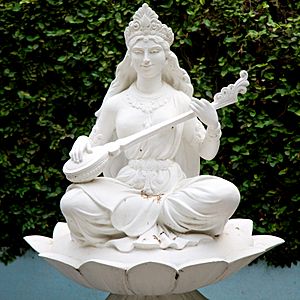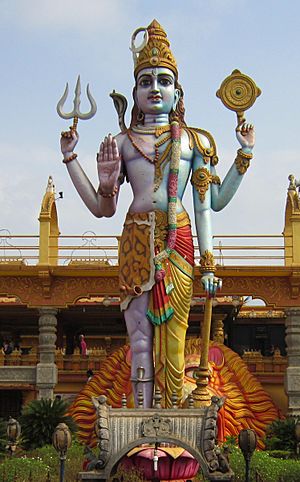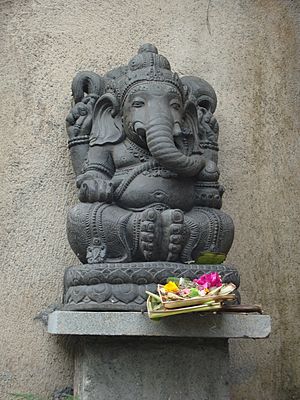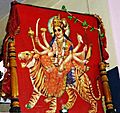Hindu gods facts for kids
The idea of God or Goddess in Hinduism is a bit different from some other religions. In Hinduism, gods are like amazing examples of strength and good character. They show us different ways to be excellent, but they aren't seen as perfect in every way and can even be questioned.
The most powerful divine energy in Hinduism is called Para Brahman. It doesn't have a shape and gives life to everything. Different forms of this supreme Brahman, known as Avatars, are worshipped by various Hindu groups.
A special idea in Hinduism is that God isn't far away in a distant heaven. Instead, God is everywhere and gives energy to the whole universe. God is also inside each soul, waiting to be found. The main goal of Hindu spirituality is to know this one Supreme God in a very personal and deep way.
Contents
The Supreme God in Hinduism
In Hinduism, three gods are often seen as the ones who started creation: Vishnu, Brahma, and Shiva.
Many Hindus worship Shiva as the Supreme God, though they might call him by different names. This is because people in India have many languages and cultures, and they have understood the one God in their own special ways.
Family traditions and where people live can really influence which god they choose to worship. Over time, four main Hindu groups developed: Vaishnavism, Shaktism, Shaivism, and Smartism.
- For Vaishnavites, God Vishnu is the Supreme God.
- For Shaktas, Goddess Shakti is supreme.
- For Shaivites, God Shiva is Supreme.
- Smartas believe all deities are different reflections of the One God, so they let each person choose which deity to worship.
Most Hindus worship a personal form of God, even though they also believe in the more abstract idea of a Supreme God.
Other Hindu Deities
Hindus also believe in many other deities. These are called Deva (for male deities) and Devi (for female deities). These words mean "heavenly" or "divine."
Devas and Devis represent the powers of nature. Some also represent important values, like Varuna and Mitra. Each deity symbolizes special knowledge, creative energy, or amazing powers.
Devas and Devis should not be confused with the Supreme God. These deities have their own personalities and powers. However, they are often seen as different parts or aspects of Brahman. They are often shown in human form, or sometimes as part human and part animal. They can also be shown as non-living things or plants. Ancient Hindu texts describe the human body as a temple, with deities living inside it.
Hindu scriptures suggest that if someone has a specific wish, they can worship a particular deity to help fulfill it. For example, shopkeepers often keep a statue or picture of the devi Lakshmi in their shops, hoping for good business.
Some of the most important Devas mentioned in the Rigveda (an ancient Hindu text) are Indra, Agni (the fire god), and Soma. Agni is often called the friend of all humanity. Indra and Soma are celebrated in a special fire ritual called a yajna, which is part of major Hindu ceremonies. Other gods like Savitr, Vishnu, Rudra (who later became known as Shiva), and Prajapati (later Brahma) are also Devas.
These various forms of God are a big part of the colorful Hindu culture. You can find them in countless paintings, statues, murals, and stories in temples, homes, businesses, and other places. Each Hindu group worships the Supreme God and its own set of divine beings.
Avatars: Deities Coming to Earth
Hindu stories often talk about the idea of an Avatar. An Avatar is when a deity comes down to Earth in a physical form. It's like a god appearing in the world.
The idea of Avatars is most developed in the Vaishnavism tradition, and it's especially connected to Vishnu. His most famous Avatars are Rama and Krishna. Vishnu takes many Avatars in Hindu stories. Different texts explain that Vishnu appears as an Avatar to bring back balance to the universe whenever evil becomes too strong and causes suffering.
Hindu Temples and Worship
In Hinduism, deities and their images can be found in a Hindu temple, inside a home, or even as a small charm. The way Hindus worship is known by different names, but a common one is Puja.
Puja is like welcoming, hosting, and honoring the deity you choose as a special guest. It's a way to remember the spiritual meaning and feelings that the deity represents to the worshipper.
Worshipping deities, visiting temples, and doing Puja are not strict rules in Hinduism; they are optional. For some Hindus, it might be a daily routine. For others, it might be a periodic ritual or something they do less often.
Understanding Hindu Icons (Murti)
Hinduism has a very old and rich tradition of creating images, especially in the form of Murti. A Murti itself is not the god in Hinduism. Instead, it is an image of God that holds emotional and religious meaning. Just like a photograph of a person isn't the real person, a Murti is an image in Hinduism, not the real thing. But in both cases, the image reminds you of something important and real. When someone worships a Murti, it's believed to be a way to connect with the spirit of the deity. The worshipper's spiritual ideas and needs are thought about through the Murti.
A Murti of a Hindu deity is usually made by carving stone, working with wood, casting metal, or making pottery. Old texts describe the correct sizes, positions, and hand gestures for these images. They are found in Hindu temples or homes, where they might be treated like a beloved guest and used in Puja rituals.
Main Hindu Deities Across India
| Name | Other Names | Avatārs or Related Deities | Where Worshipped |
|---|---|---|---|
| Vishnu | Nārāyana, Venkateshwara, Jagannatha, Dattatreya, Hari, Other names of Rama and Krishna |
Matsya, Kurma, Varaha, Narasimha, Vamana, Parashurama, Rama, Krishna, Kalki, Vithoba, Perumal, Balarama, Mohini, Buddha, Hayagriva | India, Nepal, Sri Lanka |
| Shiva | Mahādeva, Pashupati, Tripurantaka, Vishwanatha, Dakshinamurthy, Kālāntaka, Bhairava, Rudra, Nataraja, Sadashiva, Dattatreya |
Batara Guru (Indonesia) Achalanatha (Japan) |
India, Nepal, Sri Lanka |
| Brahmā | Aadi-Prajāpati, Virinci, Vaidyanaatha, Vakpati, Varishta-deva, Kamalaja, Srashtaa, Kartaa, Dhaataa | Bonten (Japan), Phra Phrom (Thailand) |
India, Nepal, Sri Lanka, Southeast Asia |
| Ganesha | Ganapati, Vināyaka, Lambodara, Gajānana | Kangiten (Japan) | India, Nepal, Sri Lanka |
| Kārtikeya | Skanda, Murugan, Mangal, Kumaraswamy, Subramanya, Shanmuga | India, Sri Lanka, Malaysia, Nepal | |
| Pārvati | Uma, Devi, Gauri, Durga, Kāli, Annapurna |
Umahi (烏摩妃, Japan) Dewi Sri (Indonesia) |
India, Nepal, Sri Lanka |
| Lakshmi | Sri Devi, Gajalakshmi, Kamalāsanā | Sita, Radha, Kisshōten (Japan) Nang Kwak (Thailand) |
India, Nepal, Sri Lanka |
| Saraswati | Vāgishvari, Vīnāpāni, Sharda | Benzaiten (Japan), Biàncáitiān (China), Thurathadi (Myanmar), Suratsawadi (Thailand) |
India, Nepal, Java, Bali, Sri Lanka |
| Durgā | Pārvati, Kāli, Mahishāsuramardini |
Betari Durga (Indonesia) | India, Nepal, Sri Lanka |
| Kāli | Durga, Parvati | India, Nepal, Sri Lanka | |
| Mariamman | Durga, Parvati | India (mostly in South India), Southeast Asia, Sri Lanka |
|
| Harihara (Half Vishnu - Half Shiva) | ShankaraNarayana | India, Sri Lanka, Nepal | |
| Ardhanārīshvara (Half Shiva - Half Parvati) | India, Nepal, Sri Lanka | ||
| Hanuman | Anjaneya, Maruthi, Bajarangbali, Langura, Sankatmochan, Pavanasut | India, Nepal, Sri Lanka |
See also
 In Spanish: Divinidades hinduistas para niños
In Spanish: Divinidades hinduistas para niños
- Hindu denominations
- Hindu iconography
- Hindu mythology
- Puranas
- List of Hindu deities
- Rigvedic deities
Images for kids









